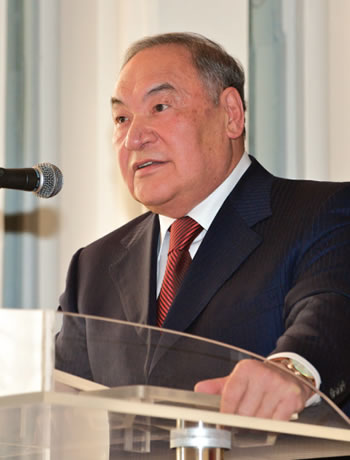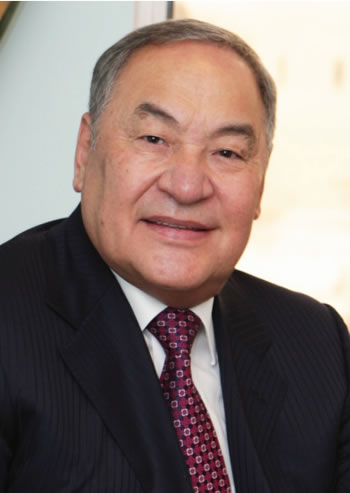Oil Generals
Ravil Cherdabayev: «Tengiz Makes a Worthy Contribution to the Development of Kazakhstan»
At the beginning of April of the current year the joint venture Tengizchevroil celebrated the 25 anniversary of its operation in Kazakhstan. Chevron was the first major investor that came to the young country, which was born on the ruins of the collapsed Soviet Union. Today, TCO is the largest producer company in the country and the largest taxpayer to Kazakhstan's budget.

Ravil Cherdabayev is a man who had a direct involvement in the development of the joint venture. On April 6, 1993, by the decree of the President of the Republic of Kazakhstan Nursultan Nazarbayev he was appointed the first Director of TCO. Coming from a known in Kazakhstan Cherdabayev oil dynasty, whose overall working experience in the oil industry exceeds 1200 years, Ravil Tazhigarievich knows, perhaps, all about Tengiz: since its establishment and up to today's heyday...
- Ravil Tazhigarievich, what Tengiz meant to the oil industry of the Soviet Union? You worked at Tengizneftegas at the end of the 80's, how was the field developing during those years?
-To better understand the value of Tengiz for the country, I'll give a small insight into history. As it is known, a powerful oil production in the Soviet Union began in the 50’s of the twentieth century from the Northern Caucasus, the Urals, the Volga region, and having passed the peak, in the mid-60's it started to decrease there. During this period, oil fields in Tyumen launched production, leveling the drop in production, active development in Western Siberia commenced, and by early 70’s the Soviet Union already produced up to 350 million tons of oil. In 1975, already 490 million tons were produced, and in 80’s this figure reached 600 million tons. And this level of 600 million with a slight decrease/increase kept up till 1990.
Strategic development of the oil and gas industry in Kazakhstan took place in 60’s. I think that the Caspian Sea region, including Western regions of Kazakhstan, according to the Union’s Centre, was to become the new powerful Center of oil production in the former Soviet Union in the beginning of the 21st century .
In 1961, Uzen, Zhetybai and other fields were discovered, decision was made to create a powerful fuel-energetic complex on the Mangyshlak peninsula. Area with reserves of oil and gas, professional staff trained at the oldest Emba fields, the availability of export pipeline, close to the sea and railway - it was all a favorable basis for increasing oil and gas production. Meaning that it's not Siberia, with more or less comfortable conditions for work, for rotation workers, and Europe is closer. Thus, he Caspian Sea region was to provide further increase in production and an increase in oil exports of the Soviet Union. The heads of regional and national bodies constantly, relentlessly raised these concerns with Moscow.
In 1979, when Nursultan Nazarbayev became the Secretary of the Central Committee of the Communist Party of Kazakhstan, he gathered us at the meeting with the leaders of the national and Soviet ministries and agencies, where issues were discussed regarding the accelerating exploration and increase in discoveries of oil and gas fields. And since then the development of the oil and gas industry always remains in his focus. It was decided to start full-scale geological surveys and work intensified. Later, when President Nursultan Nazarbayev has headed the Government, he constantly brought to the West of Kazakhstan the Chairman of the Soviet Council of Ministers Nikolay Ryzhkov, head of the USSR Planning Committee Nikolay Baybakov, heads of ministries and academics, urging them to the need for more active development of the Caspian fields and the allocation of the necessary funds.
1979 was remarkable, this year two major fields were discovered: Tengiz with more than 3 billions of geological oil reserves and Karachaganak with 1 billion 200 million tons of crude oil and 1.3 trillion cubic meters of natural gas. At the same time geophysical and satellite studies of the Caspian Sea shelf were carried out, which, according to the results of the information received, has been recognized as a promising region for oil and gas.
When in 1986 world oil prices collapsed, the Soviet economy found itself in a difficult position, if previously the Soviet Union received 10-15 billion dollars per year through exports of oil and petroleum products, not the influx of petrodollars fell to 5 billion, for three consecutive years. And this was the period when it was necessary to begin to develop the Tengiz field, but there was no required anti corrosion equipment and money to buy it. That is why, perhaps, it was decided to bring the cooperation of foreigners who would commit themselves to finance the development of Tengiz.

- How and when did you first learn about the upcoming collaboration with the Americans?
- From mid 70’s, commissioned by Embaneft association, drill-men from Volgograd and other oil-producing centers of the country were working at Tengiz, which led to the discovery in 1979 of the Tengiz field, biggest in the 20th century. The increase in the number of wells drilled and the need for their operation, the famous fire at the 37th well, which could not be eliminate for more than a year, led to the understanding that for the effective development of the field it is necessary to create an independent administration. In 1985, Tengizneftegas association was created, which consisted of Tengizneft Field Office, as well as oil and gas processing plant, which was under construction at the time.
In April 1987, I was appointed as the Deputy Chief Engineer of Tengizneftgas PA. My main task was to ensure the scientific and technical policy. Tengiz is a truly unique field. Attitude of bed started from 4.5 thousand meters, reservoir pressure around 900 atmospheres, high temperature at the exit, deadly hydrogen sulfide content reached 25 percent, mercaptan and other harmful impurities were found in oil composition. Tengiz had to be studied in detail to be operated correctly.
Hundreds of institutions from all over the Soviet Union, dozens of design bureaus and factories worked on a contract basis at Tengiz. Under the agreement the subsurface considerations were conducted by the All-Union Scientific Research Institute of Geology in Moscow, issues related to the reservoir engineering were researched by the Moscow Institute of Oil and Gas Industry, named after I.M. Gubkin, field development was designed by the Giprovostokneft Institute in Samara, gas processing by VNIPIgazpererabotka in Krasnodar, and so on. There was intent to create a new anti corrosion equipment. For these research activities annually was allocated about 20 million rubles (at the time, 1 US dollar was equal to 68 kopecks).
At the end of 1988, representatives of Chevron Corporation started visiting, got acquainted with the course of development, construction of production facilities, residential town, infrastructure. They were always accompanied by a representative of the Ministry of oil and gas from Moscow. And we have already begun to understand why they come and what they look for. But we were not directly involved in the negotiating process.



